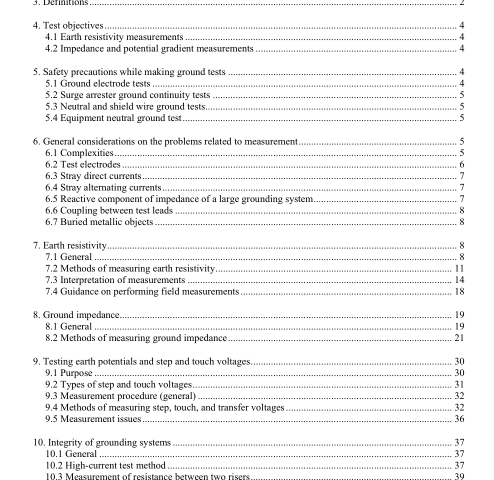IEEE 81-2012 pdf download.IEEE Guide for Measuring Earth Resistivity, Ground Impedance, and Earth Surface Potentials of a Grounding System
1.1 Scope
The test methods and techniques used to measure the electrical characteristics of the grounding system include the following topics:
a) Establishing safe testing conditions
b) Measuring earth resistivity
c) Measuring the power system frequency resistance or impedance of the ground system to remote earth
d) Measuring the transient (surge) impedance of the ground system to remote earth
e) Measuring step and touch voltages
f) Verifying the integrity of the grounding system
g) Reviewing common methods and procedures for performing ground testing
h) Reviewing instrumentation characteristics and limitations
i) Reviewing various factors that can distort test measurements
1.2 Purpose The purpose of this guide is to present practical instrumentation methods that may be used for measuring soil resistivity, the impedance to remote earth, step and touch voltages, and current distributions in ground grids associated with electric utility facilities.
These grids typically consist of interconnected grounding systems ranging in complexity from a few ground rods to large grids with many ground rods or wells, buried conductors, and external ground connections. External ground connections may include overhead shield/ground/neutral wires, underground cable sheaths/neutrals, counterpoises, grid tie conductors, metallic pipes, and other connections that provide additional paths to remote earth.
This guide is intended to assist the engineer or technician in obtaining and interpreting accurate, reliable data. The factors that influence the choice of instruments are discussed along with a presentation of field techniques for various types of measurements. These factors include the purpose of the measurement, the accuracy required, the types of instruments available, the possible sources of error, and the nature of the ground or grounding system under test. It also describes test procedures that promote the safety of personnel and property, and it seeks to minimize operating interferences with neighboring facilities. 2. Normative references The following referenced document is indispensable for the application of this document (i.e., it must be understood and used, so each referenced document is cited in text and its relationship to this document is explained). For dated references, only the edition cited applies. For undated references, the latest edition of the referenced document (including any amendments or corrigenda) applies. IEEE Std 80 TM , IEEE Guide for Safety in AC Substation Grounding. 1,2
3. Definitions
For the purposes of this document, the following terms and definitions apply. The IEEE Standards Dictionary Online should be consulted for terms not defined in this clause.
apparent soil resistivity: The equivalent, overall resistivity of a volume of soil with varying properties.
bonding: The electrical interconnecting of conductive parts, designed to maintain a common electrical potential.
counterpoise (overhead lines) (lightning protection): A conductor or system of conductors, typically arranged beneath a transmission or distribution line, located most frequently below the surface of the earth and connected to the grounding system of towers or poles supporting the line.
coupling: The association of two or more circuits or systems in such a way that power or signal information is transferred from one to another.
electric potential difference: The potential energy per unit charge between two points in an electric field.
equipotential line or contour: The locus of points having the same potential at a given time.
ground: A conducting connection, whether intentional or accidental, by which an electric circuit or equipment is connected to the earth, or to some conducting body of relatively large extent that serves in place of the earth.
ground current: A current flowing into or out of the earth or its equivalent serving as a ground.
ground electrode: A conductor embedded in the earth and used for collecting ground current from or dissipating ground current into the earth.IEEE 81 pdf download.IEEE 81-2012 pdf download
IEEE 81-2012 pdf download

Leave a Reply